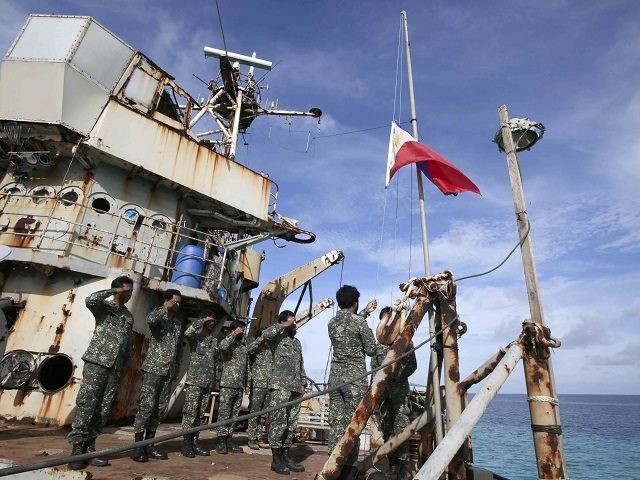Philippines Defense Secretary Delfin Lorenzana said on Friday his government will protect its interests in the South China Sea – or, as Manila prefers, the West Philippine Sea – despite Chinese aggression in the region, promising that Philippine ships would continue to patrol the area and troops will continue to be stationed in the Spratly Islands.
The Philippine Star quoted Lorenzana promising to “protest China” if it takes actions that are “not consistent with our national interest”:
The Philippine Navy will also continue to maintain its presence in the West Philippine Sea amid China’s aggressive actions in the disputed waters.
Lorenzana said the crew of BRP Sierra Madre, a Navy ship that ran aground on Ayungin Shoal in 1999, would stay in the area.
“We will still continue with our activities there. We will patrol regularly … [and] continue strengthening our islands. We have nine islands,” Lorenzana said.
The notion that a Philippine naval vessel ran aground in 1999 and the crew is still there, receiving regular supply drops from home no matter how much it annoys the Chinese, might sound odd.
The Sierra Madre was a decommissioned U.S. Navy ship sold to the Philippines in the 1970s. It was deliberately grounded on the Second Thomas Shoal in 1999, depositing a unit of Filipino marines whose mission was to stake a claim on the reef – the geopolitical equivalent of stealing second base and sliding into the bag just ahead of the incoming baseball.
The ship is now a rusty improvised base for the permanent Filipino occupying force. The Philippine navy keeps sending them supplies, while the Chinese coast guard attempts to block the supply shipments. The Filipinos protested in May when a Chinese helicopter buzzed a small rubber boat bringing supplies to the marines stationed on the Sierra Madre, accusing the Chinese chopper of attempted to “harass and overturn it.”
A much more modern Philippine warship, the BRP Gregorio del Pilar, ran aground on another shoal in the Spratly chain in September. When Manila informed Beijing of the accidental grounding to avoid misunderstandings and said it would immediately commence operations to recover the vessel, the Chinese muttered that maybe now would be a good time to haul away the Sierra Madre as well. The Filipinos continue liking the Sierra Madre exactly where it is.
The Chinese occasionally threaten to sink the Sierra Madre or tow it away. The Filipinos respond that doing so would be treated as an act of war – against both the Philippines and the United States – because they still consider the dilapidated ship to be an active-duty naval vessel.
“Derelict, as it may be, it is subject to full sovereign immunity and any attempt to tow it away from Ayungin may finally trigger the applicability of the U.S.-Philippine Mutual Defense Treaty,” a Filipino lawyer explained in 2014. That lawyer was Harry Roque, who went on to serve current Philippine President Rodrigo Duterte as a spokesman.
Roque made those comments after the Chinese managed to block a supply shipment to the nine marines stationed on the Sierra Madre at the time. “We are marines, and we adapt. We went fishing,” one of them said.
In his press conference on Friday, Lorenzana said the Chinese are still harassing supply shipments to Filipino troops stationed in the Spratlys. He also stated that permanent housing will soon be constructed for the Filipinos stationed on Pag-asa Island, which is just big enough to support a runway. China claims ownership of the island but several hundred Filipinos are stationed there.
“We have allotted funds for the shelter of our troops because right now, they only have huts there. We should give them good shelters, barracks, especially in Pag-asa,” the defense secretary said.
The Filipinos are also working on repairing Pag-asa’s runway, a project due to be completed by the end of 2019. Lorenzana revealed earlier in December that when China’s ambassador to the Philippines was told of these plans, “he came to me and said: ‘No.’”

COMMENTS
Please let us know if you're having issues with commenting.